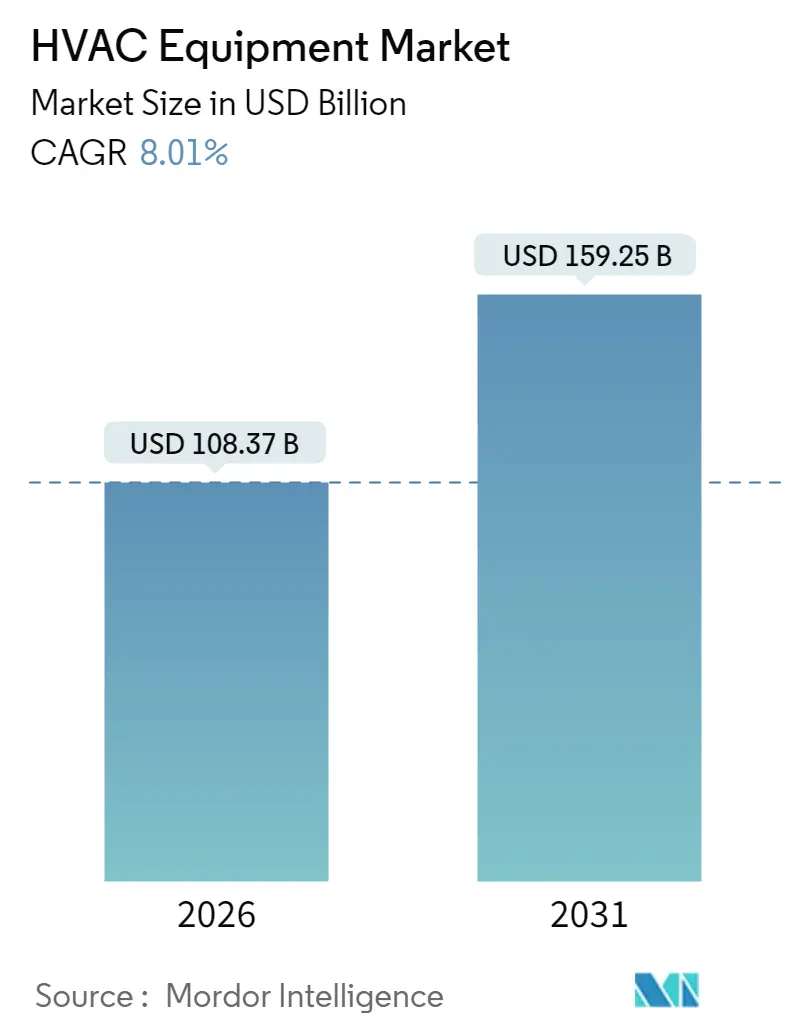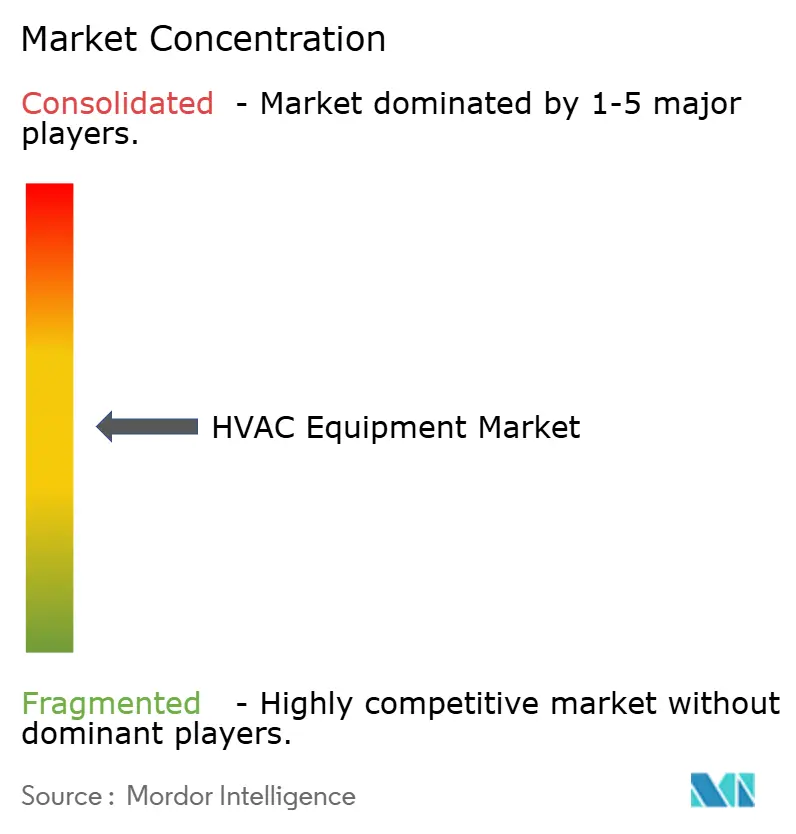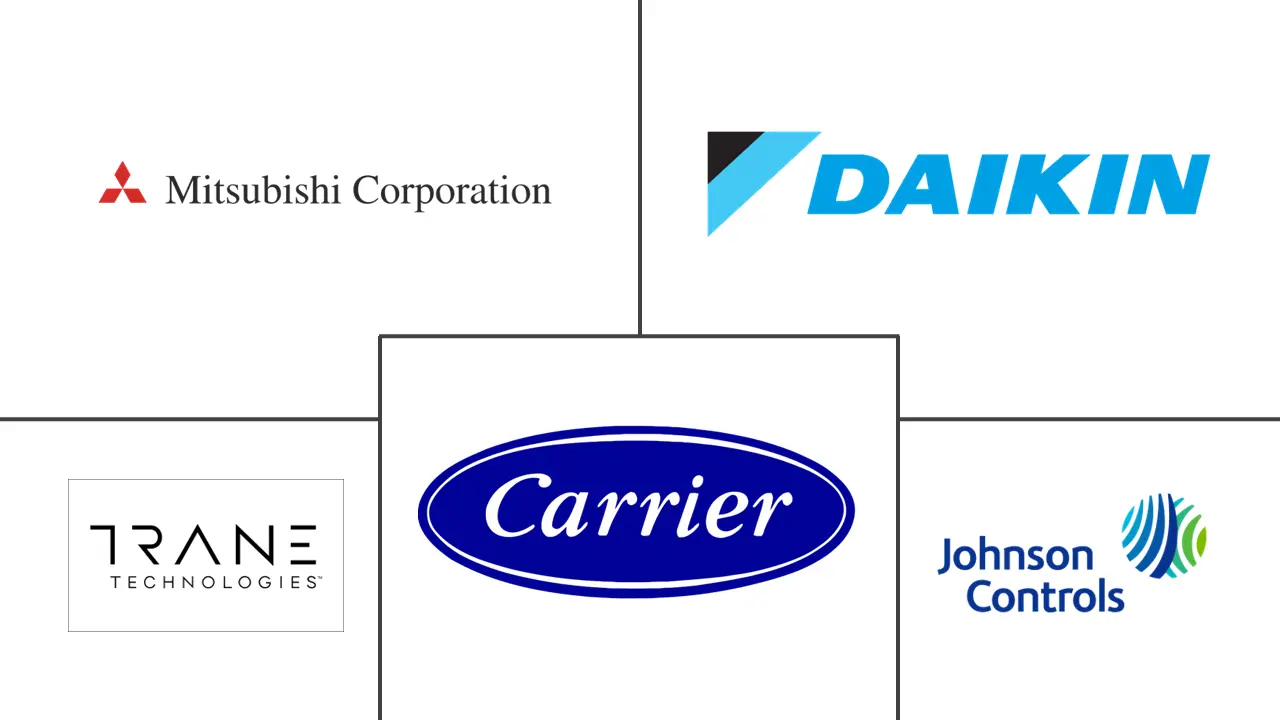
HVAC Equipment Market Analysis by Mordor Intelligence
The HVAC equipment market was valued at USD 100.33 billion in 2025 and estimated to grow from USD 108.37 billion in 2026 to reach USD 159.25 billion by 2031, at a CAGR of 8.01% during the forecast period (2026-2031). Growth momentum rests on tightening energy-efficiency rules, the pivot to low-GWP refrigerants and digital-control upgrades that lift both operating performance and end-user value. Demand is broad-based: heat-pump incentives in Europe and North America are reshaping heating portfolios, data-center build-outs are straining traditional cooling designs and urbanization in Asia keeps room-air-conditioner volumes rising. Consolidation among tier-one vendors is accelerating as OEMs race to lock in software talent and cold-climate heat-pump IP, while regional specialists are moving into unserved niches such as solar-hybrid systems for remote sites. Short-term supply frictions tied to the January 2025 refrigerant deadline are likely to ease by 2027, setting a clearer runway for premium electrification solutions.
Key Report Takeaways
- By equipment type, air-conditioning units led with 45.62% of HVAC equipment market share in 2025, whereas VRF systems are projected to expand at a 12.49% CAGR to 2031.
- By installation type, retrofit and replacement captured 62.78% of the HVAC equipment market size in 2025; new-construction installations are expected to post the fastest 9.18% CAGR through 2031.
- By end user, residential applications accounted for 41.05% of the HVAC equipment market size in 2025, while data centers are advancing at a 14.56% CAGR through 2031.
- By geography, Asia-Pacific held 34.42% of the HVAC equipment market in 2025; the Middle East is forecast to register the strongest 10.44% CAGR between 2026-2031.
Note: Market size and forecast figures in this report are generated using Mordor Intelligence’s proprietary estimation framework, updated with the latest available data and insights as of January 2026.
Global HVAC Equipment Market Trends and Insights
Drivers Impact Analysis
| DRIVER | (~) % IMPACT ON CAGR FORECAST | GEOGRAPHIC RELEVANCE | IMPACT TIMELINE |
|---|---|---|---|
| Stringent building-energy codes in Europe accelerating heat-pump adoption | +1.2% | Europe (spillover North America) | Medium term (2-4 years) |
| Surge in data-center construction in Nordics and FLAP-D elevating precision-cooling deman | +1.8% | Nordics, Frankfurt, London, Amsterdam, Paris, Dublin | Short term (≤ 2 years) |
| Rapid uptake of VRF systems in high-rise Asian residential complexes | +1.4% | China, Japan, South Korea, Southeast Asia | Medium term (2-4 years) |
| Inflation Reduction Act tax credits catalyzing early furnace-replacement cycles | +0.9% | United States | Short term (≤ 2 years) |
| District-heating expansion in Eastern Europe spurring large-capacity boiler retrofits | +0.7% | Eastern Europe, Russia | Long term (≥ 4 years) |
| Solar-hybrid HVAC packages gaining traction in off-grid African mining camps | +0.5% | Sub-Saharan Africa | Medium term (2-4 years) |
| Source: Mordor Intelligence | |||
Stringent Building-Energy Codes in Europe Accelerating Heat-Pump Adoption
Europe’s near-zero-energy-building mandate moved heat-pump installations 38% higher in 2024 versus 2022, pushing penetration in new builds to half of all units sold across the bloc. Nordic countries now deploy heat pumps in more than 60% of new homes, and large-capacity variants are entering commercial retrofits, creating a durable pull for cold-climate technology providers[1]Thomas Schmidt, “European Heat Pump Market Analysis 2025,” European Heat Pump Association, ehpa.org
Surge in Data-Center Construction in Nordics and FLAP-D Elevating Precision-Cooling Demand
Rack densities topping 30 kW, a 35% annual leap in cooling capacity and 65% growth in Swedish-Norwegian build-starts are fuelling liquid-cooling adoption. Johnson Controls notes that data-center projects now generate 18% of its commercial HVAC revenue, up from 12% a year earlier.[2]Johnson Controls, “Thermal Management Providers for Data Centers,” Johnson Controls, johnsoncontrols.com
Rapid Uptake of VRF Systems in High-Rise Asian Residential Complexes
Multi-family tower developers in China, Japan and Korea are turning to VRF to save shaft space and add individualized comfort. Daikin posted a 22% rise in Asian VRF sales during fiscal 2024, and installations in China’s residential blocks climbed 28% year-on-year.[3]Masanori Togawa, “Annual Report 2024,” Daikin Industries, daikin.com
Inflation Reduction Act Tax Credits Catalyzing Early Furnace-Replacement Cycles
The U.S. Inflation Reduction Act (IRA) has introduced generous tax credits and rebates for energy-efficient home upgrades, including HVAC systems. These incentives are accelerating the replacement of aging furnaces with high-efficiency alternatives, particularly in colder states. This early-cycle replacement is creating a short-term demand spike for residential HVAC manufacturers and installers, especially those offering ENERGY STAR-certified systems.
Restraints Impact Analysis
| RESTRAINTS | (~) % IMPACT ON CAGR FORECAST | GEOGRAPHIC RELEVANCE | IMPACT TIMELINE |
|---|---|---|---|
| High up-front cost of low-GWP refrigerant transition for OEMs | –0.8% | Global (higher in North America and Europe) | Short term (≤ 2 years) |
| Talent shortage of certified HVAC technicians in mature markets | –1.2% | North America, Western Europe, Japan | Medium term (2-4 years) |
| Semiconductor supply-chain volatility constraining VRF-inverter availability | –0.7% | Global (pronounced Asia) | Short term (≤ 2 years) |
| Stringent F-Gas quotas in EU increasing compliance burden for importers | –0.6% | European Union | Medium term (2-4 years) |
| Source: Mordor Intelligence | |||
Talent Shortage of Certified HVAC Technicians in Mature Markets
Industrywide redesign outlays now exceed USD 10 billion and have lifted average system prices 8-12%, a short-lived drag until economies of scale improve after 2026
High Up-Front Cost of Low-GWP Refrigerant Transition for OEMs
Industry redesign costs above USD 10 billion have pushed average system prices 8-12% higher, dampening near-term uptake until scale economies arrive
Segment Analysis
By Equipment Type: Air-Conditioning Dominates While VRF Accelerates
Air-conditioning units contributed 45.62% to the HVAC equipment market in 2025 as rising temperatures and urban middle-class growth kept demand resilient. Residential room air conditioners in China reached 73% penetration that year [cheaa.org]. Ductless mini-splits advanced 18% annually in North America, where homeowners want zonal comfort without duct retrofits.
VRF remains the fastest-growing sub-segment, expanding at a 12.49% CAGR through 2031. Hospitals, hotels and mixed-use towers prize its simultaneous heating-cooling flexibility. Mitsubishi Electric recorded a 32% jump in global VRF installations in 2024

Note: Segment shares of all individual segments available upon report purchase
By Installation Type: Retrofit Market Dominates Amid Aging Infrastructure
Retrofit and replacement activity represented 62.78% of the HVAC equipment market size in 2025, largely because systems commissioned during the 2005-2010 boom have reached end of life. Harvard research shows U.S. household HVAC replacements rose 14% in 2024 as owners chased lower utility bills.
New construction, although smaller, is forecast to climb 9.18% annually. Stricter 2023 U.S. energy-code updates lifted minimum efficiency thresholds 15%, prompting builders to specify premium packages. Performance-based retrofits continue to gain ground, with Johnson Controls indicating such contracts account for 32% of its retrofit backlog
By End User: Residential Leads While Data Centers Surge
Residential applications still anchor revenue at 41.05%, underpinned by replacement cycles and IAQ concerns. Smart thermostats equip 32% of U.S. houses with central systems, lifting connectivity demand.Commercial premises hold 37.82% but data centers outpace all sub-verticals; cooling now absorbs roughly 40% of their capital outlays. Average power density reached 12.7 kW per rack in 2024, intensifying the need for liquid or direct-to-chip solutions.
Industrial facilities, at 21.13%, are integrating energy-recovery ventilators to manage process heat while compressing operating costs.

Note: Segment shares of all individual segments available upon report purchase
By Building Type (Commercial): Data Centers Drive Premium Cooling Demand
Data centers have moved to the front of the commercial HVAC market. They generated 22.48% of commercial equipment revenue in 2025 and are projected to rise at a 14.56% CAGR from 2026 to 2031. Server rack densities now often top 30 kW, so operators are shifting toward precision and liquid-based cooling systems that carry higher price tags. As a result, data-center contracts make up 18% of Johnson Controls’ commercial HVAC sales, a share that keeps climbing.
Traditional office buildings still hold the largest slice at 27.21%, but growth has eased to 4.14% per year because hybrid work reduces floor-space demand and pushes owners toward retrofit projects that lower energy bills instead of new installations. Healthcare facilities command 18.05% and are expanding at 8.61% on the back of stricter air-quality and infection-control rules that call for advanced filtration and tightly managed airflow. Retail stores and malls account for 15.71%; e-commerce caps new-build activity, yet managers continue to replace legacy units to improve shopper comfort and cut operating costs. Schools and universities make up 12.04% of spending, growing 6.74% as districts upgrade aging systems to meet tougher indoor-air standards. Hotels and leisure venues hold the final 4.51% share and are advancing 5.33% annually as global travel returns to pre-pandemic levels, requiring precise temperature and humidity control to keep guests comfortable.
Geography Analysis
Asia-Pacific controlled 34.42% of the HVAC equipment market in 2025, driven by urban construction and middle-income expansion. China alone made up 42% of regional value, though its annual growth cooled to 6.73% as real-estate activity stabilized [daikin.com]. Japan and Korea favor high-spec VRF and air-purification models, while Vietnam and Indonesia post double-digit gains on commercial builds.
North America accounted for 29.03%, buoyed by robust replacement demand and a 32% surge in U.S. heat-pump sales following Inflation Reduction Act incentives [carrier.com]. Data-center and healthcare projects lifted commercial revenue 22%.
Europe held 24.16%; heat-pump shipments climbed 17% in 2024 despite macro headwinds. HVAC upgrades made up 38% of EU renovation-wave spending as member states schedule fossil-fuel phaseouts.
The Middle East is the fastest-growing pocket, forecast at a 10.44% CAGR, with Saudi Arabia’s Vision 2030 adding large-scale district-cooling capacity and UAE developers adopting VRF at speed.

Competitive Landscape
The HVAC equipment market features moderate concentration: the top eight vendors command roughly 65% of global revenue. Active M&A—132 deals in 2024—centers on software analytics, cold-climate heat-pump patents and regional channel access. Early investment in R-32 platforms let Daikin gain share in residential AC, while Carrier’s equity stake in ZutaCore amplifies its position in high-density data-center cooling.
OEM rivalry differs by tier. Premium segments emphasise digital twins, predictive maintenance and ultra-low-GWP refrigerants; volume lines compete on distribution reach and cost. Emerging white-space lies in pharmaceutical clean-process solutions and solar-hybrid packages for off-grid mining, areas where mid-cap specialists are already carving profitable niches.
Connected-service revenue is rising twice as fast as hardware. Trane Technologies reports software-enabled services equal 22% of its commercial HVAC turnover, underscoring the pivot from mechanical differentiation to outcome-based contracts
HVAC Equipment Industry Leaders
Daikin Industries Ltd
Carrier Global Corp.
Trane Technologies PLC
Johnson Controls Int. PLC
Mitsubishi Electric Corp
- *Disclaimer: Major Players sorted in no particular order

Recent Industry Developments
- January 2025: Trane Technologies posted record Q4 2024 revenue of USD 4.5 billion, citing strong bookings for high-efficiency commercial systems.
- February 2025: Carrier invested in ZutaCore to scale direct-to-chip liquid cooling for data centers.
- February 2025: Daikin committed USD 300 million to expand Texas output of VRF systems and heat pumps.
- March 2025: Carrier’s Q1 2025 sales rose 4% year-on-year to USD 5.3 billion, aided by a 28% increase in data-center cooling revenue.
Global HVAC Equipment Market Report Scope
HVAC equipment is an indoor and vehicular environment comfort technology that provides thermal comfort and acceptable indoor air quality. It is an integral part of residential structures, such as single-family homes, apartment buildings, hotels, and senior living facilities, as well as medium-to-large industrial and office buildings, such as hospitals, where safe and healthy building conditions are regulated, with respect to temperature and humidity, using fresh air from outdoors.
The HVAC equipment market is segmented by heating equipment (by product type [boilers and furnaces, heat pumps, unitary heaters], by end-user [residential, commercial, industrial, others], by geography [North America, Europe, Asia-Pacific, Rest of the World]), by ventilation equipment (by product type [air handling units, humidifiers, and dehumidifiers, air filters, fan coiling unit], by end-user [residential, commercial, industrial, others], by geography [North America, Europe, Asia-Pacific, rest of the World]) and by air condition equipment (by product type [unitary air conditioners [ducted splits, ductless mini splits, indoor packaged and roof tops], room air conditioners, packaged terminal air conditioners, chillers], by end user [residential, commercial, industrial, others], by geography [North America, Europe, Asia-Pacific, rest of the World]). The report offers market forecasts and size in value (USD) for all the above segments.
| Heating Equipment | Boilers and Furnaces | |
| Heat Pumps | ||
| Unitary Heaters | ||
| Ventilation Equipment | Air Handling Units | |
| Humidifiers and Dehumidifiers | ||
| Air Filters | ||
| Fan Coil Units | ||
| Air-Conditioning Equipment | Unitary Air Conditioners | Ducted Splits |
| Ductless Mini-Splits | ||
| Packaged Rooftops | ||
| Variable Refrigerant Flow (VRF) Systems | ||
| Room Air Conditioners | ||
| Packaged Terminal Air Conditioners | ||
| Chillers | ||
| New Construction |
| Retrofit / Replacement |
| Residential |
| Commercial |
| Industrial |
| Office Buildings |
| Healthcare Facilities |
| Hospitality and Leisure |
| Retail Stores and Malls |
| Educational Institutions |
| Data Centers |
| North America | United States |
| Canada | |
| Mexico | |
| South America | Brazil |
| Argentina | |
| Chile | |
| Europe | Germany |
| United Kingdom | |
| France | |
| Italy | |
| Spain | |
| Asia-Pacific | China |
| India | |
| Japan | |
| South Korea | |
| ASEAN | |
| Middle East | Saudi Arabia |
| United Arab Emirates | |
| Turkey | |
| Qatar | |
| Africa | South Africa |
| Nigeria | |
| Egypt |
| By Equipment Type | Heating Equipment | Boilers and Furnaces | |
| Heat Pumps | |||
| Unitary Heaters | |||
| Ventilation Equipment | Air Handling Units | ||
| Humidifiers and Dehumidifiers | |||
| Air Filters | |||
| Fan Coil Units | |||
| Air-Conditioning Equipment | Unitary Air Conditioners | Ducted Splits | |
| Ductless Mini-Splits | |||
| Packaged Rooftops | |||
| Variable Refrigerant Flow (VRF) Systems | |||
| Room Air Conditioners | |||
| Packaged Terminal Air Conditioners | |||
| Chillers | |||
| By Installation Type | New Construction | ||
| Retrofit / Replacement | |||
| By End User | Residential | ||
| Commercial | |||
| Industrial | |||
| By Building Type (Commercial) | Office Buildings | ||
| Healthcare Facilities | |||
| Hospitality and Leisure | |||
| Retail Stores and Malls | |||
| Educational Institutions | |||
| Data Centers | |||
| By Geography | North America | United States | |
| Canada | |||
| Mexico | |||
| South America | Brazil | ||
| Argentina | |||
| Chile | |||
| Europe | Germany | ||
| United Kingdom | |||
| France | |||
| Italy | |||
| Spain | |||
| Asia-Pacific | China | ||
| India | |||
| Japan | |||
| South Korea | |||
| ASEAN | |||
| Middle East | Saudi Arabia | ||
| United Arab Emirates | |||
| Turkey | |||
| Qatar | |||
| Africa | South Africa | ||
| Nigeria | |||
| Egypt | |||
Key Questions Answered in the Report
How big is the HVAC Equipment Market?
The HVAC Equipment Market size is expected to reach USD 108.37 billion in 2026 and grow at a CAGR of 8.01% to reach USD 159.25 billion by 2031.
Which region leads the HVAC equipment market?
Asia-Pacific leads with 34.42% of global revenue thanks to rapid urbanization and construction activity.
Why are VRF systems growing so quickly?
VRF offers zonal comfort and high efficiency, making it popular in high-rise residential and mixed-use buildings, driving a 12.49% CAGR forecast to 2031.
How are refrigerant regulations affecting manufacturers?
The 2025 low-GWP mandate forces costly product redesigns, lifting system prices 8-12% in the short term but accelerating efficiency innovation.
What end-user segment is expanding fastest?
Data centers, propelled by AI computing workloads, are forecast to grow at a 14.56% CAGR through 2031 due to rising precision-cooling needs.
Are technician shortages a serious constraint?
Yes. North America alone faces a 225,000-technician shortfall by 2026, extending installation lead times and tempering short-term growth



